Fashion
DIY (Do It Yourself) Cloth Face Mask
With highly contagious coronavirus (COVID19) rapidly spreading throughout the world, many people are shopping for surgical masks to protect against this dangerous disease.


With highly contagious coronavirus (COVID19) rapidly spreading throughout the world, many people are shopping for surgical masks to protect against this dangerous disease.
The sudden increase in demand for “Personal Protective Equipment” (PPE) and the interrupted supply lines in China have led to a critical shortage of small particle filtering face masks (N-95s) and fitted rectangular sneeze guards (“surgical masks”).
News reports, appropriately seeking to reserve limited supplies of these disposable items for medical institutions, have been asking people not to purchase these items. Public officials have been quoted suggesting – inaccurately – those face coverings can’t help prevent the spread of this new virus.
The truth is more complicated:
COVID19 is spread from person-to-person in droplets of moisture, mucus and saliva from people with infections. Coughing, sneezing, and even normal breathing put these virus particles into the air. One sneeze can put out thousands of droplets.
People standing less than 6 feet away may become covered with these virus particles while they are still in the air. After the droplets fall, the virus particles can remain active for up to nine days.
Infection occurs when someone breathes in airborne droplets, or when they touch their mouth, nose or eyes with hands covered in virus particles that have fallen out of the air onto counters, handrails, floors or other surfaces.
Wearing a face mask stops people from becoming infected in two ways:
1) By blocking most airborne droplets filled with virus from being inhaled
2) By stopping the wearer from touching their own mouths and noses.
Studies have shown that medical professional using surgical face masks correctly get 80% fewer infections than those who don’t.
So why the mixed messages?
First, because the protection only comes when the masks are used properly. They must be put on clean, taken off carefully, and paired with rigorous hand washing, and the discipline not to touch the face.
Second, because gaps around the masks and between fibers, even in commercial surgical masks, are too large to block all viruses. Sneeze and cough droplets are usually between 7 and 100 microns. Surgical masks and some cloth masks will block 7 micron particles. The COVID19 virus particles are 0.06 to 0.14 microns.
So why should you make your own face masks?
1) In the event you become sick, having a supply of masks at home will give some level of protection to friends and family while you seek medical advice. It will certainly be better than no mask at all (see research notes).
2) By making your own, and hopefully for family and friends, you will be decreasing demand on limited supplies of industrially manufactured, disposables, which are desperately needed by hospitals and nursing homes.
3) These comfortable, curved shaped masks rest closer to the face, with fewer gaps, than rectangular surgical masks.
4) Our homemade designs are washable, making them environmentally friendly.
Supplies:
Mask 1 is fitted, with 2 layers of fabric and a pocket between them for an optional filter (see research links for info on filters). It is held on by elastic ear loops. Elastic can also be threaded to fit around the head.
Mask 2 is fitted, with 2 layers but no pocket, and is easier to make.
seam allowances are ¼” unless noted
MASK 1 & 2 supplies (child, regular and large size):
9″ x 15″ fabric outer layer
9″ x 15″ fabric lining layer
(3 regular or large size masks of either design, can be made from 1/4 yard (9″) of 45” wide fabric)
3” piece of soft wire (this can be decorative wire as shown, or picture wire, or even a paper clip if that’s all you can find)
approx. 22” of elastic cord (child size length 10″, regular size length 11-12″, large size length 13″)
WHAT KIND OF FABRIC?
You can choose any tightly woven cotton or cotton/poly fabric you like. Hold it up to the light to see how tight the weave is. Use the same fabric for outer and lining if you want, or use different ones to help you remember which side is clean and which dirty.
The research (see links at the end) shows 100% cotton having some effectiveness. Cotton/polyester blends may have additional properties of repelling water, making them better barriers to keep droplets from soaking through outer layers.
Don’t use stretchy, sequined or velvet material.
Wash all fabrics before sewing to pre-shrink, and to assure you are working with the most sanitary materials possible.
Step 1: Pattern, Cut, Center Seam
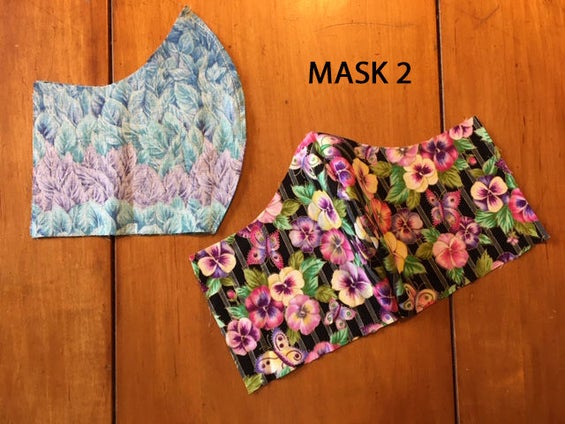
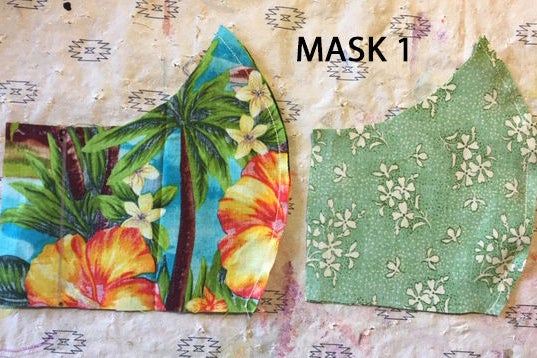
Print out PDF paper pattern piece(s) at actual size on 8.5” x 11” paper. For MASK 1 print file called “Mask 1 reg size pattern”. It has 2 pieces: A (outer) and B (lining) . For MASK 2, print either “Mask 2 reg size pattern” or “Mask 2 large pattern” or “Mask 2 child pattern”. It just has one piece. At this time I don’t have a large or child size pattern for a Mask 1. Will work on that. Cut out the paper pattern pieces.
For those without a printer – I will upload a gridded image soon so you can draw it yourself, meanwhile do what you can with the measurements:
Mask 1 piece A is 6.25″ h x 6.25″ w. B is 6.25″ h x 4.75″ w
Mask 2 child is 5.25″ h x 5.5″ w,
For Mask 2 regular is 6.25″ h x 6.25″ w,
And for Mask 2 large is 6.75″ h x 6.75″ w
Fold your fabrics right sides together.
MASK 1
Pin pattern(s) to folded fabrics and cut two A and two B. Transfer the 2 dots from pattern onto the two A pieces on wrong side of fabric. Pencil a line between them lightly on each piece.
MASK 2
Pin pattern piece to folded fabrics (outer and lining). Cut 4.
Sew center curves of outer layers, right sides together. Sew center curves of lining layers, right sides together. Clip the curved seam at about ½” intervals but not down to the seam.
Step 2: MASK 1 Sides, Sleeves for Elastic
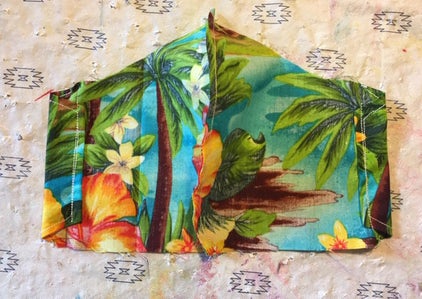


For MASK 1 (with pocket)
Fold straight sides of lining fabric toward wrong side, and sew fold down with straight stitch.
On outer layer sides, fold top and bottom corners down, using the dotted lines on pattern and the transferred dots as guides. Pin. Fold raw edge over and pin. Ironing helps keep this in place. Stitch along all the 3 folds on each side, 1/8” from fold.
Make the sleeves for the elastic – With wrong side up, fold angled, stitched ends of outer layer up to the pencil line. Stitch down.
Step 3: MASK 1 Connect Layers, Elastic
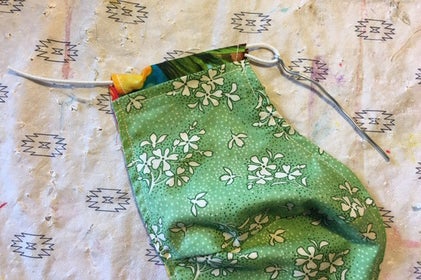

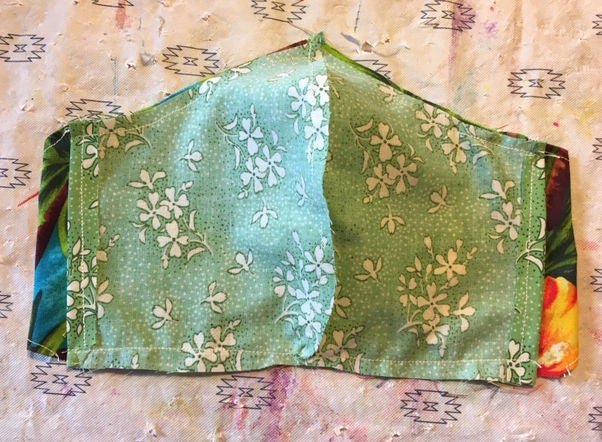
Lay inner layer over outer layer, right sides facing in. Sew the top edge and the bottom edge. Clip curved seam.
Turn right side out. Top stitch the top and bottom seams, 1/8” from edge. This will assure both layers stay in place during laundering.
Feed elastic through the sleeves (approx. 11” per side). A wire needle or small safety pin can help feed it through.
Step 4: MASK 1 Nose Wire, Elastic, Filter

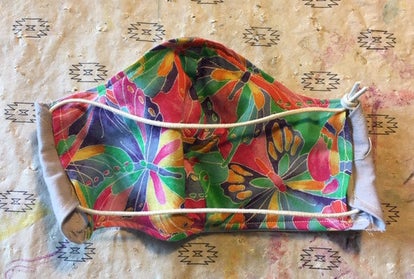
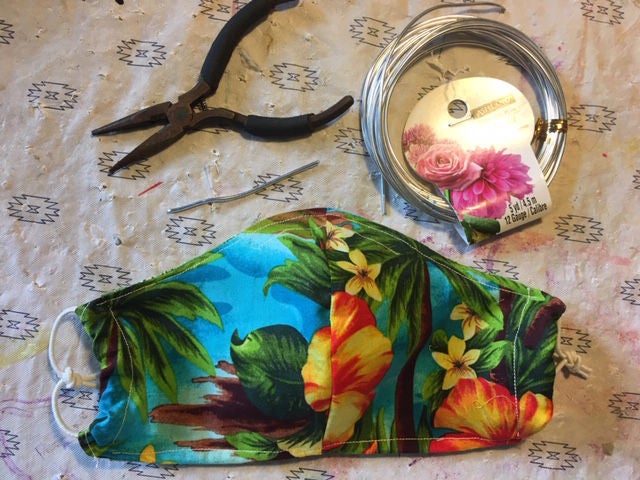
Make a channel to hold the nose wire by stitching a line 1/4” from the top stitch line, echoing the curve (2” on each side). Slide a 3”ish piece of wire into the slot created (loop the ends first with pliers if they are sharp). Sew the ends of the channel closed.
Tie ends of elastic into loops and fit mask to your head by tucking loops behind ears. Adjust knots as needed. It should fit snugly but not pull on your ears. If desired, you can make the elastic go around the back of the head. Don’t cut the elastic in half. Feed each end of the 16″ length through the sleeves in a U shape. Tie together and fit mask. Adjust knot as needed for snug fit.
Bend the wire to fit snugly over the bridge of your nose.
Optional: If you have a suitable filter material, you can increase the filtering capacity by slipping this material into the pocket between the outer layer and the lining. Cut whatever filter material to fit as needed. See research notes for more about what might be suitable.
Step 5: MASK 2 Instructions


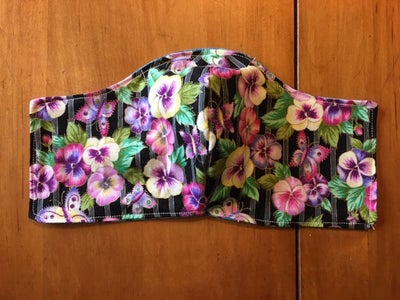
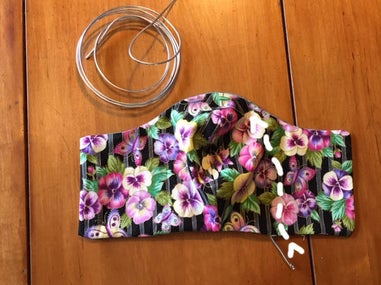
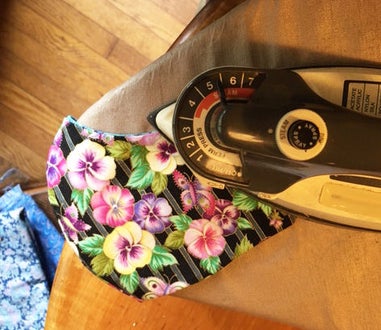
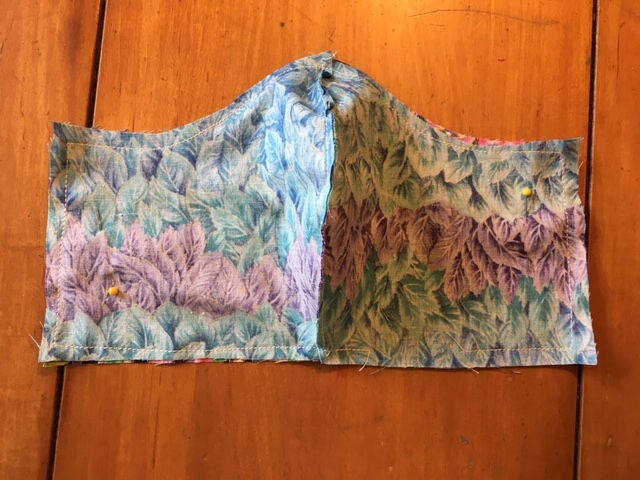
For MASK 2 (easier, no pocket)
Pin right sides of outer and lining layers facing each other. Sew all the way around the edge, except for a 1.5″ gap on the bottom edge. Turn right side out and press.
Note – the pointy end of an ironing board is the perfect size and shape to press these masks on.
Sew the wire channel, 1/2″ down from edge and 2″ to each side of the center seam. See picture.
Slide the wire through the turning hole, into the wire channel. Stitch the ends of the channel closed so it won’t move around when washed.
Top stitch 1/8″ around the entire mask, closing up the turning hole as you do.Be careful of the wire. You can skip that section of top stitching if there isn’t enough room to go above the wire.
Lay mask with lining side up on table and fold 1″ of each end of the mask toward the center. Pin and sew, making the elastic channels.
See Step 4 of MASK 1 for how to thread the elastic.
Step 6: Conclusion & About Us
Conclusion:
We recommend making 3 masks per person: one to wear, one in the wash, one for a spare or to share. Remember, always remove the mask carefully. Do not reach under the mask with dirty hands. Touch dirty to dirty, clean to clean. Wash your hands and face immediately after removing mask. For best results in cleaning masks – immediately upon removing, spray the front and back with hydrogen peroxide to kill germs, then wash in soap and hot water.
About us:
We are artist Jen Murphy, and medical professional Sabra Stein. We are worried about protecting our family and friends from contagious disease. Help from other friends have further developed the sizes and the new simpler MASK 2 design. Thanks Chris and Sheila!
We adapted this design from several sources online, including Craftpassion.com. New information about the disease is released daily. This is what we think is the best way to do it, as of March 15, 2020.
We make NO CLAIMS that these masks will protect you from covid19. Use at your own risk.
Step 7: Research Links
These are the places I got my info, as well as talking to medical workers. Do your own research and please share in comments if you find new relevant information.
Most important article, please read even if you don’t read anything else:
How to put on and remove a face mask https://www.sfcdcp.org/communicable-disease/health…
STUDIES
Oxford Academic 2010 https://academic.oup.com/annweh/article/54/7/789/2…
University of Cambridge 2013 https://www.researchgate.net/publication/25852580…
National Institute of Health 2013 https://www.ncbi.nlm.nih.gov/pmc/articles/PMC3785..
CDC INFO ON CLOTH MASKS
CDC instructions for simple mask.
https://wwwnc.cdc.gov/eid/article/12/6/05-1468_art…
Low on actual instructions, high in scientific reference. This is their official word about cloth masks:
“Unlike NIOSH-approved N95s, facemasks are loose-fitting and provide only barrier protection against droplets, including large respiratory particles. No fit testing or seal check is necessary with facemasks. Most facemasks do not effectively filter small particles from the air and do not prevent leakage around the edge of the mask when the user inhales.The role of facemasks is for patient source control, to prevent contamination of the surrounding area when a person coughs or sneezes. Patients with confirmed or suspected COVID-19 should wear a facemask until they are isolated in a hospital or at home. The patient does not need to wear a facemask while isolated.”
CDC “Strategies for Optimizing the Supply of Facemasks:
https://www.cdc.gov/coronavirus/2019-ncov/hcp/ppe-…
ARTICLES
Can DIY homemade masks protect us from coronavirus? https://smartairfilters.com/en/blog/diy-homemade-…
What are the Best Materials for Making a DIY Face Mask?*
https://smartairfilters.com/en/blog/best-materials…
*Author notes on this one
All of the materials succeeded in blocking at least 49% of virus particles. Our mask has 2 layers of cotton or cotton/poly and so it seems like it would do as well or better that that.
What the heck is a tea towel? Like many of the materials listed in this graph, that is open to interpretations. Most people think of a flat-woven fabric made from linen or cotton. Not a terry cloth towel.
I tried a vacuum cleaner bag and you can barely suck air through it. There are different types of bags and I only tried one, but generally I think you will be sucking air from the side gaps of the mask if you use it because it’s too hard to inhale through.
Can a face mask protect you?
https://www.theguardian.com/world/2020/mar/20/can-…
If you really want to get in to the weeds, this thread has an overwhelming about of info/discussion about the topics of materials and filters and patterns. The FB group itself has relevant info on many PPE topics
https://www.facebook.com/groups/opensourcecovid19m…
Household products that kill Covid19
https://www.consumerreports.org/cleaning/common-ho…
How Long Corona Virus will last on surfaces
https://www.livescience.com/how-long-coronavirus-l…
FILTER INFO
This is what is inside an N95 mask according to: https://www.accessdata.fda.gov/cdrh_docs/pdf12/K12..
“[It] is flat-folded and expands into a convex-shaped mask with polyamide/spandex elastic head-loops to secure the mask to the user’s face, and a malleable aluminum strip positioned above the nose fora tighter seal around the nose and face. The respirator is comprised of four layers of material: an outer layer of spun-bond polypropylene, a second layer of cellulose/polyester, a third layer of melt-blown polypropylene filter material and an inner (fourth) layer of spun-bound polypropylene…The outer active layer of the respirator is coated with a hydrophilic plastic. The second inner layer is treated with copper and zinc ions. Both layers inactivate influenza viruses using different mechanisms of action.”
So if you can reproduce some of these protective elements you are increasing effectiveness. Let’s look at them one by one:
Spun-bond polypropylene is a textile material that is composed of thermally bonded, continuous filaments in a web-like structure. Here is a list of things that use spun bond polypropylene/polyester, including weed cover and mattress covers: http://www.excelnonwovens.com.au/spunbond-polyprop…
Cellulose/polyester – what it is https://www.filters.com/product-category/liquid-fi…
Clean room wipes like this would probably work and they are a good size already. But they may also be in short supply. I’m going to try and buy some.
melt-blown polypropylene – made of micro- and nanofibers where a polymer melt is extruded, forming a nonwoven sheet product applicable for filtration and apparels. Still working on finding accessible examples of this.
This could be a game-changer. “made by crossing and aligning fine nanofibers to create small air holes that block viruses while allowing for easy breathing”. Not approved by the South Korean government yet. Meant to be slid into washable masks. Keep an eye on these developments
I am still trying to find an easily acquired, safe material that can be used effectively. Here is a list of things people are trying that may have some effectiveness: furnace air filters highest grade, vacuum cleaner bags, non-woven sewing interfacing.
Many thanks to ashevillejm for this content.










Pingback: Coronavirus: Newsom avoids clashing with Trump as he charts state’s coronavirus response - The Viral Bros News
Pingback: Cristiano Ronaldo could be forced to leave Juventus due to coronavirus crisis - The Viral Bros News